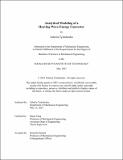Analytical Modeling of a Heaving Wave Energy Converter
Author(s)
Tyshchenko, Valeriia
DownloadThesis PDF (2.819Mb)
Advisor
Yang, Maria
Terms of use
Metadata
Show full item recordAbstract
A broad review of wave power is offered, covering its history as well as the gaps and barriers in its development. The cost of wave power commercialization is identified to be a major challenge, driving the need to prioritize and structure theoretical efforts in order to find a focus area for the largely diffused investment. Specifically, it is proposed to shift the theoretical emphasis from analyzing existing wave energy converters using complex numerical simulation methods to employing simple analytical models in early-stage design decision-making, such as finding the most promising mode of wave power generation to dedicate research efforts to.
The heaving converter type is therefore chosen as an example of using simple analytical analysis in evaluating maximum theoretical capability of a single wave power generation mode – vertical translation. Given evidence of successful application of control theory to approximating wave interactions, a linear control theory-based model of a simplified heaving device is proposed, with the necessary wave theory background discussed in detail. The implementation of the model in MATLAB and the associated optimization of the converter design parameters are described in the context of a case study that uses experimental ocean data.
It has been found that a heavier heaving converter shaped like a streamlined cylindrical buoy can absorb 99.7% of the wave energy input. On the other hand, a lighter bluff buoy absorbing 30.1% of the energy has twice as large of a frequency bandwidth. Nevertheless, it should be noted that the bandwidth values are far from typical wave frequencies which leads to a conclusion that bandwidth does not carry practical importance in the context of the model developed.
A sensitivity analysis looking into dependence of both the coefficient of absorption and the bandwidth on the buoy design parameters is performed. The assumptions behind the model as well as its limitations are discussed.
The heaving model proposed can serve as a starting point in the process of selecting a wave power generation mode with the most theoretical potential. It can also be used as a basis for developing more complex analytical techniques to complement or substitute resource-intensive numerical tools with more efficient approaches.
Date issued
2023-06Department
Massachusetts Institute of Technology. Department of Mechanical EngineeringPublisher
Massachusetts Institute of Technology